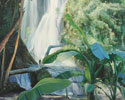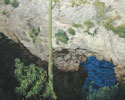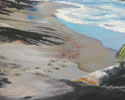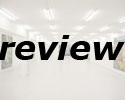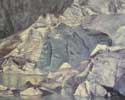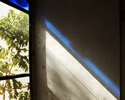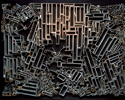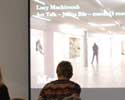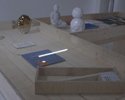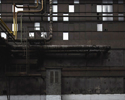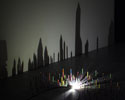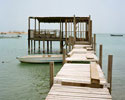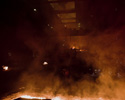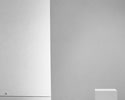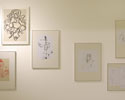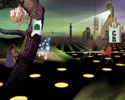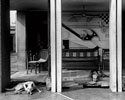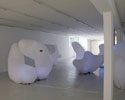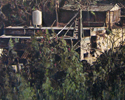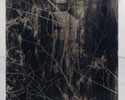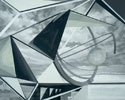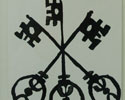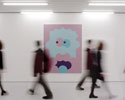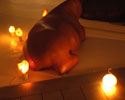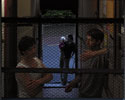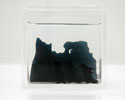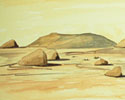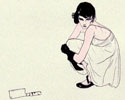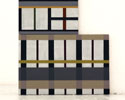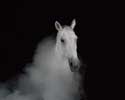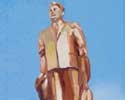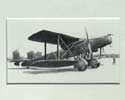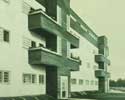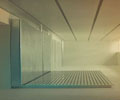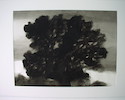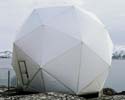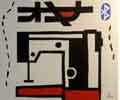|
GALERIE LUCY MACKINTOSH ARTISTS SHOWS INFORMATION EVENTS |
|||||||||
|
| |||||||||
| |||||||||
| "When Life Began" Michael Ashcroft | |||||||||
| Michael Ashcroft | |||||||||
| Vernissage le jeudi 19 octobre 2006 Ouverture du 20 octobre au 2 décembre 2006 | |||||||||
 | |||||||||
| Galerie Lucy Mackintosh, Lausanne, Switzerland Michael Ashcroft's “When Life Began” An impressive and bright gallery designed by the Swiss architectural studio Décosterd & Rahm, serves as a background for five large paintings by British artist Michael Ashcroft. The number of works on display might seem negligible but the magnetism that emanates from each of these paintings fills Lucy Mackintosh Gallery with a power which approaches the sublime. The exemplary display of this exhibition, which follows the show held last spring at Max Wigram Gallery, confirms the vitality of contemporary British painting, even though German painting has the tendency to dominate the debate raised by the recent London based exhibition -maybe with too much emphasis - “The Triumph of Painting”. The inspiration for the five landscapes which constitute the show “When life Began” comes from guidebook illustrations of the 60's. Michael Ashcroft has carefully copied these images on the canvases modifying their size and a few details such as human figures, which are now naked and extremely small, almost invisible. Despite their iconographical sources and their, at a first glance, banal appearance, Michael Ashcroft's landscapes are the result of two subsequent choices, the one of the photographer and the one of the painter. These choices have contributed, and they still do, to the construction of landscape as an artistic genre, a representation of a geographical configuration or a sight one discovers from a precise point of view. Landscape painting has a long tradition; usually it functions as a contextualizing background for historical or mythological scenes, it serves as a backdrop for a scene dominated by human presence. 'Pure' landscape painting is a more recent construction considered as a genre of lesser importance. The paintings of Michael Ashcroft are doubtlessly tributary of the history of painting and of the ideologies that it can convey, but the artist paints them with an important dose of irony and cynicism. The choice of working with pictures of paradisical landscapes taken from religious magazines and travel guides is not fortuitous: these idyllic visions are used by the travel industry and by religious proselytism as promises of happiness. Within this mindset “When Life Began” sounds like a reference to Nature and Creation, as well as to the tradition of the romantic landscape, imbued with the notion of the sublime dear to Kant. In the five paintings on display nature saturates the canvas reducing human figures to simple dark stains. Man is no longer the main subject of the work of art, even though his presence is of capital importance for the functioning of the painting. Figures occupy the same territory as nature but not the same space, these two dimensions are contiguous but they don't interact. The size difference between the almighty invasive nature and the vulnerable minuscule humans functions as a repoussoir. This principle is perfectly illustrated by the marine landscape which has in the foreground an Agave flower. After having admired the beauty of the landscape depicted, the wildness of the rocky coast, the deep blue of the quiet sea, the majesty of the flower, suddenly we detect a couple on the cliff, their backs turned to the viewer, looking out at the horizon. The prodigiously tall flower hovers over the couple like a monster. The magnificences of the landscape includes feelings of anxiety, of absolute grandeur and power that emphasize the insignificance of human physical strength faced with the forces of nature. The work of Michael Ashcroft embodies what Freud has defined as “uncanny strangeness”, describing everything which should remain hidden but which has been revealed. This also happens when the distinction between fiction and reality is blurred; the mystery of this 'new world' unknown to humans is the subject of the novel by French author Michel Tournier “Vendredi ou les Limbes du Pacifique” which narrates the story of Robinson Crusoe. Like Tournier, Ashcroft explores our relationship to the wild world; on the one hand it is an attempt to grasp the rules of the social universe -here represented by the guidebook imagery and the current value of an exotic holiday- on the other hand this unknown world functions as a means of transformation of the self through the alienation of the human from his contemporary habitat and a direct confrontation with this 'new world'. Paradoxically this 'new world' is a human construction, a paradigm of what men consider as a lost paradise. Two other remarkable features of these paintings are the framing and the point of view of the spectator. Because of their huge size the paintings look like doors open on a paradise that we could easily reach: but we don't, we don't even try. These landscapes with their extraordinarily poisonous beauty keep us at a distance while they overwhelm the sporadic human beings who are imprisoned within the frames. Some have already disappeared leaving behind them only their ephemeral footprints on the sand. Man seems to be condemned to disappear in face of this luxuriant, virgin nature. Couples are painted very small and we never see their faces, the Agave flower or the banana tree occupy the foreground because the viewer is given the role of voyeur. The same happens with the advertisements of the travel agencies which transform the desert island, symbol of the exotic dream celebrated by Baudelaire and Gauguin, into a banal consumer article. Marco Costantini | |||||||||
| Show overview | |||||||||
| |||||||||
|
| |||||||||
| Archives | |||||||||
|
| |||||||||




